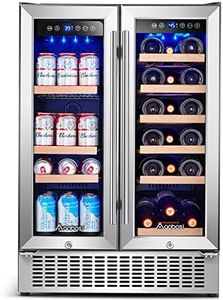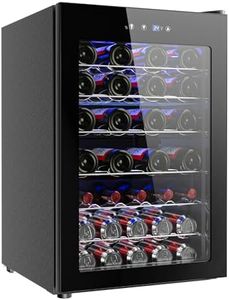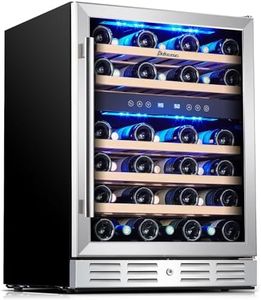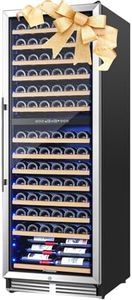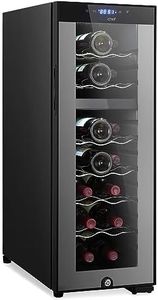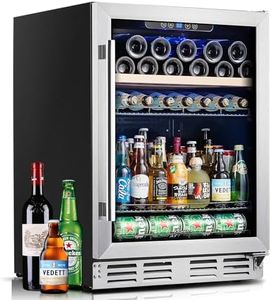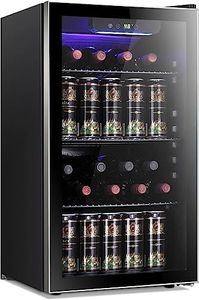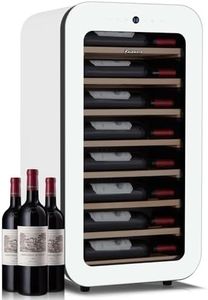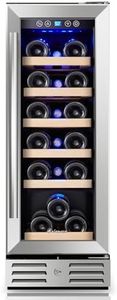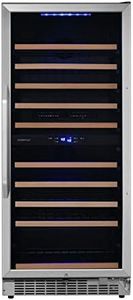10 Best Small Wine Fridges 2025 in the United States
Our technology thoroughly searches through the online shopping world, reviewing hundreds of sites. We then process and analyze this information, updating in real-time to bring you the latest top-rated products. This way, you always get the best and most current options available.

Our Top Picks
Winner
Wine Cooler 37 Bottle Freestanding Fridge with Stainless Steel Reversible Glass Door, 145 Can Beverage Refrigerator Quiet Compressor for Home Kitchen Bar, 4.5 Cu.ft Silver
Most important from
646 reviews
The Electactic Wine Cooler is a solid choice for wine enthusiasts looking for a small, freestanding fridge. It has a capacity of 37 wine bottles or 145 cans, making it versatile for both wine and other beverages. The fridge offers a wide temperature range from 32℉ to 61℉, allowing you to store various types of wines at their optimal temperatures.
The cooling system uses a high-performance compressor that maintains consistent cooling and ideal humidity levels, which is great for keeping your wines in top condition. The reversible glass door is a nice touch, as it ensures flexibility in placement and easy access from either side, while the LED interior lighting makes it convenient to find what you need. The adjustable chrome racks add to the flexibility in storage, accommodating different bottle sizes and beverage types.
There are a few drawbacks. The fridge uses a manual defrost system, which means you’ll need to periodically defrost it yourself. It is not Energy Star certified, so it may consume more energy compared to other models. Despite these minor cons, the Electactic Wine Cooler stands out with its sleek design and versatile features, making it a good addition to any home bar, kitchen, or entertainment area.
Most important from
646 reviews
Ca'Lefort 24 Inch Wine Fridge, 54 Bottle Wine Cooler Refrigerator, 40-65°F Wine Refrigerator Glass Door, 3 LED Wine Fridge, Built-in or Freestanding Wine Fridge for Home/Bar/Kitchen (5.65 cu.ft)
Most important from
268 reviews
The Ca'Lefort 24 Inch Wine Fridge is a solid choice for wine lovers needing a medium-sized cooler that fits both built-in and freestanding setups. With space for up to 54 standard wine bottles, it offers good capacity for home collections or small gatherings. The fridge has a temperature range of 40-65°F, adjustable in 1-degree increments via a digital panel, allowing precise control to suit different wine types. Its cooling system uses a compressor combined with internal air circulation, which cools efficiently and maintains an even temperature throughout. This setup is generally quieter and more energy-efficient than cheaper models relying on simpler refrigeration methods.
The double-glazed, UV-protected glass door helps preserve wine flavors by blocking harmful light and maintaining temperature stability, while the reversible door adds flexibility for placement. The interior shelves are made of durable sapele wood and can be rearranged to fit various bottle sizes, enhancing convenience. At just under 34 inches tall, the fridge is designed with user comfort in mind, including front venting that supports both built-in and freestanding installation. Users appreciate the soft LED lighting options (amber, blue, or white) that create a wine cellar ambiance.
Although the noise level is generally low, compressor units may produce more sound than thermoelectric models, which might matter in very quiet rooms. Additionally, while energy-efficient for a compressor fridge, it won’t match the lowest-energy-use models. This fridge combines efficient cooling, good capacity, and thoughtful design, making it well-suited for enthusiasts wanting reliable wine storage without complicated operation.
